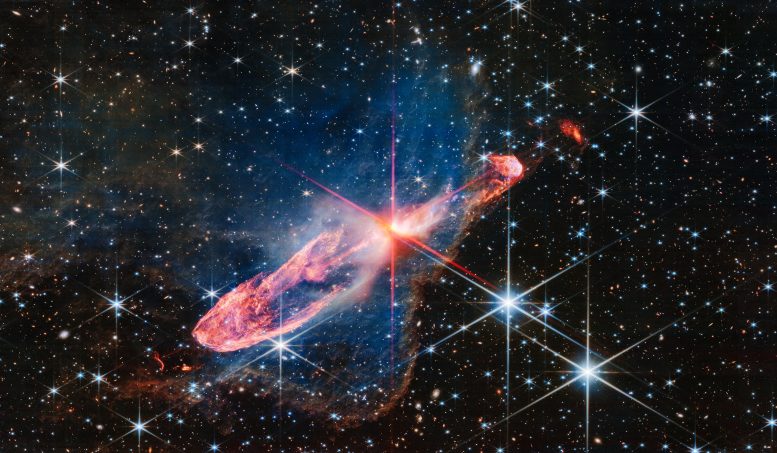
These stars have a lot of energy to let loose! NASA’s James Webb Space Telescope has captured a tightly bound pair of actively forming stars, known as Herbig-Haro 46/47, in high-resolution near-infrared light. Look for them at the center of the red diffraction spikes. The stars are buried deeply, appearing as an orange-white splotch. They are surrounded by a disk of gas and dust that continues to add to their mass. Credit: NASA, ESA, CSA, Joseph DePasquale (STScI), Anton M. Koekemoer (STScI)
Forecast: There’s a 100% chance of recurring two-sided jets for a pair of stars that are actively gathering mass.
Like kittens, actively forming stars are balls of energy. But instead of being overtaken by the zoomies, stars emit energy in the form of jets, creating fantastic, textured scenes. That’s the case for two tightly orbiting stars, known as Herbig-Haro 46/47.
NASA’s James Webb Space Telescope captured the most detailed portrait of these stars to date. The pair of actively forming stars has sent out jets in two directions for thousands of years. Although Herbig-Haro 46/47 has been studied by many telescopes, both on the ground and in space, since the 1950s, Webb is the first to capture them in high-resolution near-infrared light. With Webb, we can now understand more of the stars’ activity – past and present – and peer through the dusty blue nebula, which appears black in visible-light images, that surrounds them. Over time, researchers will be able to glean new details about how stars form.
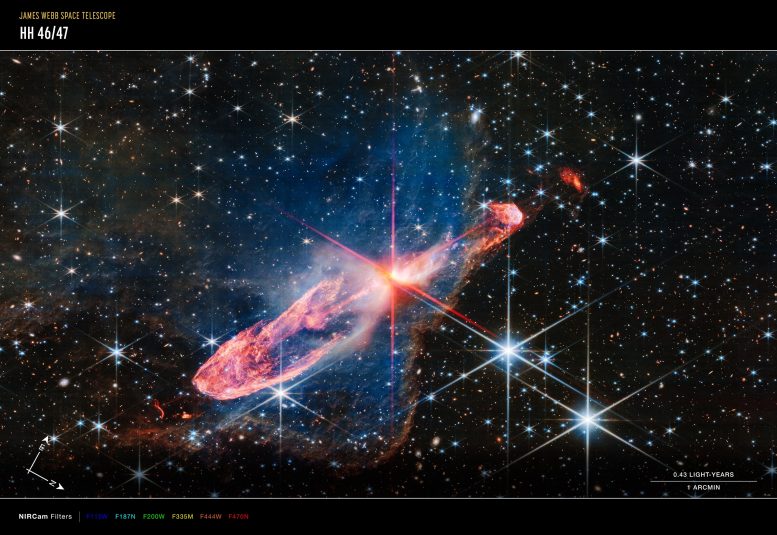
Six near-infrared images from NIRCam (the Near-Infrared Camera) aboard the James Webb Space Telescope make up this composite of Herbig-Haro 46/47.
The north and east compass arrows show the orientation of the image on the sky. Note that the relationship between north and east on the sky (as seen from below) is flipped relative to direction arrows on a map of the ground (as seen from above).
This image shows invisible near-infrared wavelengths of light that have been translated into visible-light colors. The color key shows which NIRCam filters were used when collecting the light. The color of each filter name is the visible-light color used to represent the infrared light that passes through that filter.
The scale bar is labeled in arcminutes, which is a measure of angular distance on the sky. One arcminute is equal an angular measurement equal to 1/60 of one degree. (The full Moon has an angular diameter of about 30 arcminutes.) The actual size of an object that covers one arcminute on the sky depends on its distance from the telescope.
Credit: NASA, ESA, CSA, Joseph DePasquale (STScI), Anton M. Koekemoer (STScI)
Webb Space Telescope Snaps Highly Detailed Infrared Image of Actively Forming Stars
Young stars are rambunctious!
NASA’s James Webb Space Telescope has captured the “antics” of a pair of actively forming young stars, known as Herbig-Haro 46/47, in high-resolution near-infrared light. To find them, trace the bright pink and red diffraction spikes (see infographic below) until you hit the center: The stars are within the orange-white splotch. They are buried deeply in a disk of gas and dust that feeds their growth as they continue to gain mass. The disk is not visible, but its shadow can be seen in the two dark, conical regions surrounding the central stars.
Details and Dynamics
Among the most distinctive features are the two-sided lobes that fan out from the actively forming central stars, represented in fiery orange. Much of this material was shot out from those stars as they repeatedly ingest and eject the gas and dust that immediately surround them over thousands of years.
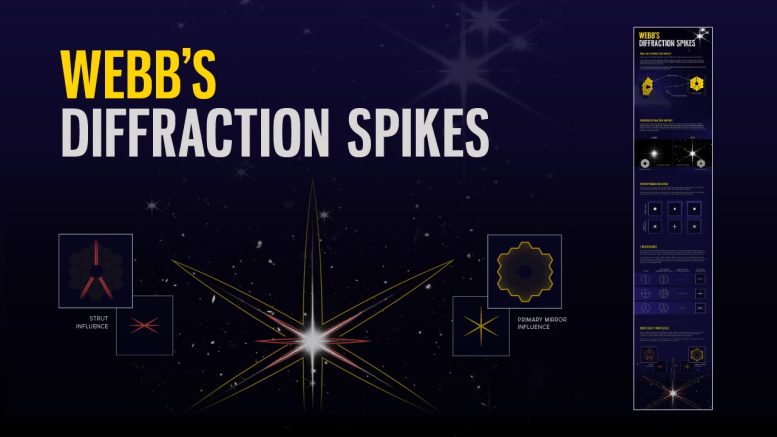
(Click image to see the full infographic.) This illustration demonstrates the science behind Webb’s diffraction spike patterns, showing how diffraction spikes happen, the influence of the primary mirror and struts, and the contributions of each to Webb’s diffraction spikes. Credit: NASA, ESA, CSA, Leah Hustak (STScI), Joseph DePasquale (STScI)
When material from more recent ejections runs into older material, it changes the shape of these lobes. This activity is like a large fountain being turned on and off in rapid, but random succession, leading to billowing patterns in the pool below it. Some jets send out more material and others launch at faster speeds. Why? It’s likely related to how much material fell onto the stars at a particular point in time.
The stars’ more recent ejections appear in a thread-like blue. They run just below the red horizontal diffraction spike at 2 o’clock. Along the right side, these ejections make clearer wavy patterns. They are disconnected at points, and end in a remarkable uneven light purple circle in the thickest orange area. Lighter blue, curly lines also emerge on the left, near the central stars, but are sometimes overshadowed by the bright red diffraction spike.
Importance of Ejections and the Nebula
All of these jets are crucial to star formation itself. Ejections regulate how much mass the stars ultimately gather. (The disk of gas and dust feeding the stars is small. Imagine a band tightly tied around the stars.)
Now, turn your eye to the second most prominent feature: the effervescent blue cloud. This is a region of dense dust and gas, known both as a nebula and more formally as a Bok globule. When viewed mainly in visible light (see image below), it appears almost completely black – only a few background stars peek through. In Webb’s crisp near-infrared image, we can see into and through the gauzy layers of this cloud, bringing a lot more of Herbig-Haro 46/47 into focus, while also revealing a deep range of stars and galaxies that lie well beyond it. The nebula’s edges appear in a soft orange outline, like a backward L along the right and bottom.
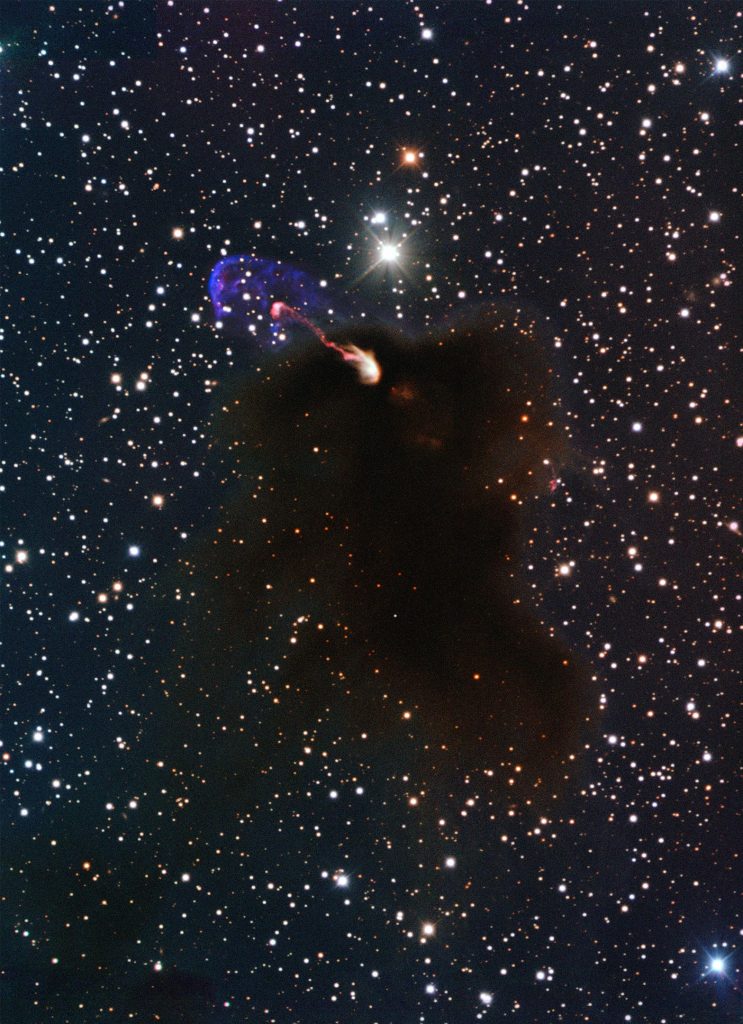
This image from ESO’s New Technology Telescope at the La Silla Observatory in Chile shows the Herbig-Haro object HH 46/47 as jets emerging from a star-forming dark cloud. This object was the target of a study using ALMA during the Early Science phase. Credit: ESO/Bo Reipurth
This nebula is significant – its presence influences the shapes of the jets shot out by the central stars. As ejected material rams into the nebula on the lower left, there is more opportunity for the jets to interact with molecules within the nebula, causing them both to light up.
Analyzing Asymmetry and Perspective
There are two other areas to look at to compare the asymmetry of the two lobes. Glance toward the upper right to pick out a blobby, almost sponge-shaped ejecta that appears separate from the larger lobe. Only a few threads of semi-transparent wisps of material point toward the larger lobe. Almost transparent, tentacle-like shapes also appear to be drifting behind it, like streamers in a cosmic wind. In contrast, at lower left, look beyond the hefty lobe to find an arc. Both are made up of material that was pushed the farthest and possibly by earlier ejections. The arcs appear to be pointed in different directions, and may have originated from different outflows.
Take another long look at this image. Although it appears Webb has snapped Herbig-Haro 46/47 edge-on, one side is angled slightly closer to Earth. Counterintuitively, it’s the smaller right half. Though the left side is larger and brighter, it is pointing away from us.
Over millions of years, the stars in Herbig-Haro 46/47 will fully form – clearing the scene of these fantastic, multihued ejections, allowing the binary stars to take center stage against a galaxy-filled background.
Location and Telescope’s Capabilities
Webb can reveal so much detail in Herbig-Haro 46/47 for two reasons. The object is relatively close to Earth, and Webb’s image is made up of several exposures, which adds to its depth.
Herbig-Haro 46/47 lies a mere 1,470 light-years away in the Vela Constellation.
The James Webb Space Telescope stands as the pinnacle of space science observatories. Spearheaded by NASA, and in collaboration with ESA and the Canadian Space Agency, Webb delves into mysteries of our solar system, distant celestial bodies, and the intricate structures of our universe.

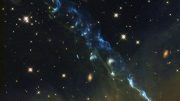
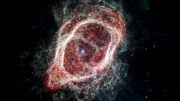
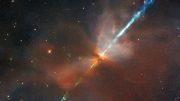
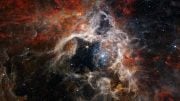

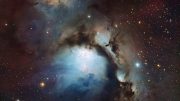
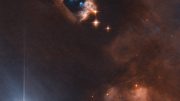
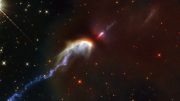
Completely remarkable and amazing!!Appre iate the share of knowledge and spectacular information